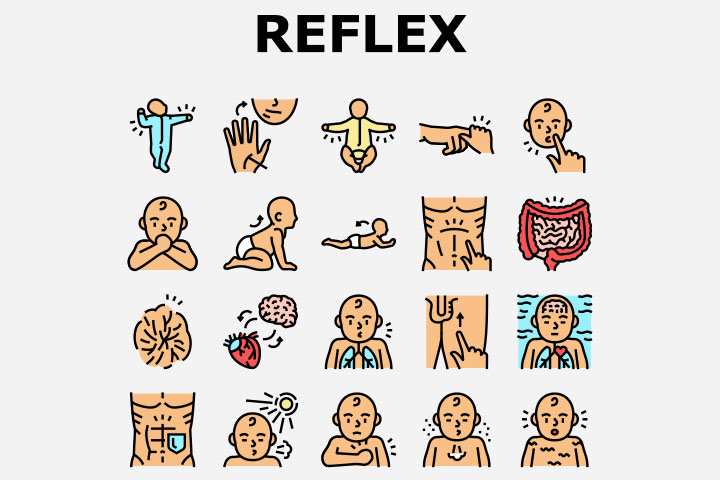Asymmetrical tonic neck reflex (ATNR), or tonic neck reflex, is one of the primitive reflexes present in an infant. It differs from the symmetrical tonic neck reflex (STNR) present in later infancy stages.
Several actions and responses of a newborn are reflex-based to specific stimuli. A reflex is a muscle’s automatic reaction or response to a stimulus (1) (2). Newborns have several innate reflexes at birth known as primitive reflexes. These last for several weeks or months and disappear as the baby grows older.
In this post, we acquaint you with the causes, purpose, and signs of asymmetrical tonic neck reflex in babies and some red flags to be alert about.
What Is Tonic Neck Reflex?
Tonic neck reflex is present at birth and occurs when the baby lies on the back. When their head turns to one side, the arm on the side to which the head turns involuntarily stretches out. The other arm bends at the elbow, and the baby may clench their fist.
Since the reflex resembles a fencer’s stance, it is also called a fencing reflex (3). This reflex is critical for a baby’s eye-hand coordination, control of posture, left-right discrimination, and gross motor skills (4).
Is Tonic Neck Reflex Normal?
Yes, tonic neck reflex is normal during the initial few months of the baby’s life. This reflex pattern develops in the fetus during the 18th week of pregnancy. The reflex usually becomes prominent between the ages of one and four months old and disappears by the age of seven months (3).
Older babies, children, and adults can also take the tonic reflex stance, but it is a voluntary action rather than an involuntary reflex (5).
What Causes Tonic Neck Reflex?
Tonic neck reflex is one of the several primitive reflexes of infancy. Primitive reflexes are natural involuntary responses ingrained in the baby’s nervous system. They occur due to specific stimuli and only for a fixed duration during infancy.
Several primitive reflexes serve certain purposes since the baby’s gross motor skills are inadequately developed. Therefore, the presence of primitive reflexes, such as tonic neck reflex, is a sign of healthy brain and nerve activity in the newborn (6).
What If A Baby Does Not Have Tonic Neck Reflex?
If your baby does not display asymmetrical tonic neck reflex during infancy, speak to a doctor. Doctors check for the presence of primitive reflexes soon after birth to determine the healthy functioning of the nervous system.
The absence of primitive reflexes, such as tonic neck reflex, may indicate damage or poor development of the baby’s nervous system (7). It may also suggest dysfunction of the central or peripheral nervous system. There is no single reason why a baby may have congenital nervous system problems. Genetic and gestational factors, such as maternal lifestyle during pregnancy, could be the influential factors.
The doctor may suggest multiple tests to determine the underlying cause of the asymmetrical tonic neck reflex’s absence. Relevant treatment or management could be suggested based on the diagnosis.
What Happens When Baby Retains ATNR?
It is considered atypical development if the baby shows ATNR after seven months. It may suggest the absence or poor development of reflex integration — an automatic process where the matured higher brain centers inhibit the reflexes and modify them to become voluntary actions (8). Babies with poor reflex integration tend to display problems with fine and gross motor skills and cognitive abilities. The presence of the ATNR can make rolling over difficult. The child’s arm will straighten when they looks in the direction they wish to roll. Rolling is an important milestone on the route to further gross motor milestones like crawling.
It may be sometimes difficult to tell if the asymmetrical tonic neck reflex in babies and toddlers is voluntary or reflexive. You may check for the presence of the following conditions that could also occur due to poor reflex integration (9) (10).
- Poor eye tracking
- Poor hand-eye coordination
- Difficulty crossing midline (Left-right confusion)
- Awkward or clumsy movements
- Issues with throwing and catching
- Difficulty in crawling, standing, or walking
Long-Term Effects Of Retained ATNR
If asymmetrical tonic neck reflex persists through the baby’s childhood, it may indicate poor reflex integration, which may also cause the following issues (11).
- Poor learning abilities and dyslexia
- Handwriting problems
- Difficulty in putting thoughts in written words
- Difficulty telling the time
- Difficulty in running, cycling, and balance
- Difficulty maintaining body’s balance
The gross motor difficulties with retained ATNR include eye-hand coordination (throwing and catching) activities where both hands are used simultaneously and need to be coordinated. In cases where the ATNR persists but is not initially diagnosed, the child can start having problems in the school-going years. This can affect reading and writing abilities.
How Is Retained Tonic Neck Reflex Treated?
The treatment of retained tonic neck reflex and other primitive reflexes could depend on the underlying cause and its severity. A common way to improve a child’s voluntary actions and inhibit primitive reflexes is through reflex integration therapy.
The therapy usually contains a series of exercises and games that stimulate coordination between various parts of the brain. It ultimately helps improve the functions of the higher brain centers, which are normally responsible for inhibiting primitive reflexes.
A therapist may design the therapy based on the symptoms shown by the child and its intensity. Below are some of the common activities used in reflex integration therapy (12).
- Motor skill development games: Sorting objects, threading pearls, clapping games, drawing, and dancing
- Integration exercises: Exercises involving walking, cycling, aiming and throwing, and catching and throwing
- Functional activities: Midline crossing activity, pushing a shopping cart, turning the head, crawling through tunnels, and walking while turning the head
Asymmetric tonic neck reflexes are a natural part of a baby’s neurological development and are not a cause for concern straight away. However, if your kid does not have tonic neck reflexes, you should consult a specialist for a proper diagnosis. If the asymmetric tonic reflexes persist after seven months, the doctor may recommend a few developmental activities or exercises to address the issue. To avoid difficulties, take good care of your child and encourage them to participate in basic activities.
Key Pointers
- The tonic neck reflex appears between one and four months of age and lasts approximately seven months.
- It is vital for a baby’s gross motor skills, hand-eye coordination, and posture control.
- Not having a tonic neck reflex is a cause of concern and may indicate neuronal dysfunction.
- The condition can be improved through reflex integration therapy that consists of targeted games, exercises, and activities.














